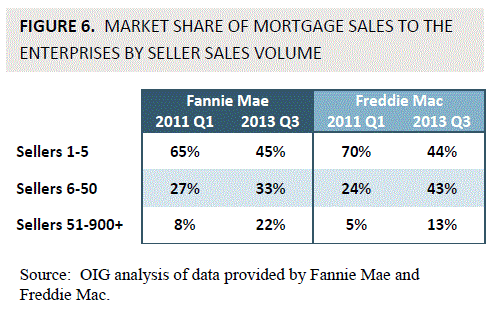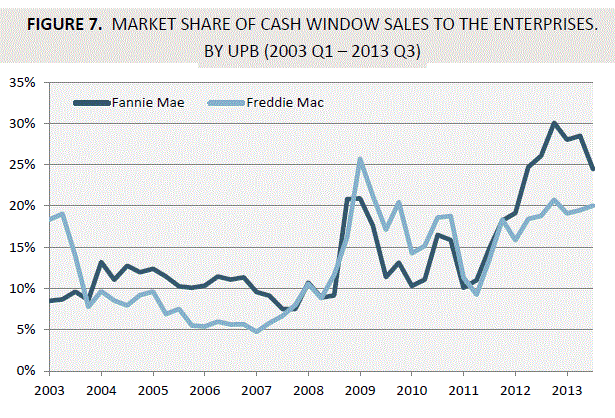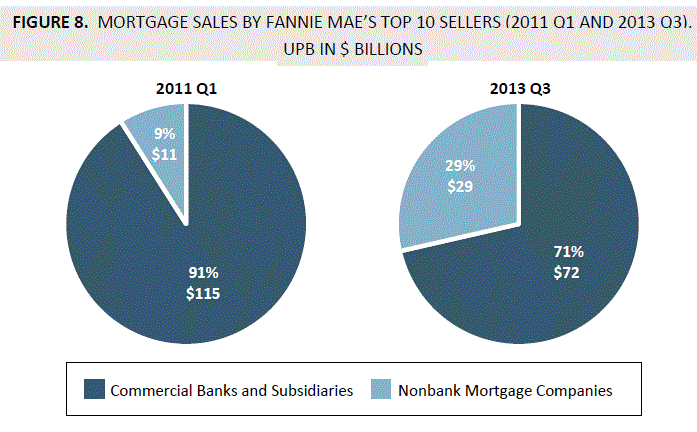Blog

Small Lenders Increased Selling Directly to GSEs a Double-Edged Sword
ThernFederal Housing Finance Agency’s Office of Inspector General (FHFA OIG) hasrnreleased an evaluation of Fannie Mae’s and Freddie Mac’s (the GSEs) increasedrnrecent level of purchases of loans from small banks, credit unions, andrnnon-bank mortgage companies. Suchrnpurchases, OIG said, presents both potential benefits and certain risks. </p
Historically thernGSEs have purchased loans from large commercial banks and other financialrncompanies that acted as loan aggregators by purchasing mortgages originated byrnsmaller lenders and bundling them with their own loans for sale. Thernaggregation system offered several benefits to participants:</p<ul class="unIndentedList"
This system changed radically afterrnthe housing crisis. Fannie Mae recently reported that only 5 of the top 20 mortgagernoriginators in 2006 are currently active in the mortgagernmarket, having failed or beenrnabsorbed by other lenders. Moreoverrnseveral largernaggregators have stopped purchasing mortgages originated by other lendersrnwhile others have reduced their aggregation activities. In early 2011, the GSEs’ top five sellers delivered between 65% and 70% of the mortgagesrnpurchased by eachrnGSE. By the third quarter of 2013 thesernpurchase had dropped to less than half. </p
In response many credit unions,rnthrifts, smaller banks, and nonbank mortgage companies have stepped up their directrnsales to the GSEs which have seen a steady increase in their number of their active mortgage seller counterparties. Between late 2007 and latern2013 this number grew by an average of about 30%rnfor the two GSEs. At Fannie Mae, the smallest sellers-those outside the top 50-gained the most market share, increasing from 8% to 22%, while itrnwas mid-tier sellersrnat Freddie Mac which expanded market share from 24% to 43%.</p
 </p
</p
Lenders can sell loans to the GSEs in one of twornways. They can swap the loans for GSE mortgagernbacked securities backed by the same loans then sell them to investors or theyrncan sell the mortgages to the GSEs for cash after which the GSEs securitizesrnthe mortgages and sell them to investors themselves. Either way the mortgages end-uprnas part of a GSErnmortgage-backed security (MBS) and lenders obtain cash they can use to make additional loans, creatingrnliquidity for the housing finance market.rn</p
In exchange for a “the guaranteernfee,” the GSEs guarantee that investorsrnwill continue to receivernthe timely payment of principal and interest on their MBS regardless of the credit performance of the underlying mortgages. The GSEs have established ongoing post-purchasernquality reviews to determine conformance with their underwriting standards andrnmay require lenders to repurchase mortgages that do not comply. Since the financial crisis the GSEs havernrecovered nearly $100 billion through assertion of repurchase claims.</p
Traditionally,rnsmaller lenders have sold their mortgages to the GSEs for cash because such salesrnare less operationally challenging than MBS swaps so it is not surprising that thernmarket share of cash-window sales has increased significantly over the past fewrnyears. Those sales grew to between 20% andrn25% of each GSEs’ total mortgage purchase volume by late 2013 with Fannie Mae’srncash window sales increasing at a faster rate than Freddie Mac’s.</p
 </p
</p
In conducting its evaluation, OIG identifiedrnseveral reasons why the surviving aggregators may no longer serve as conduitsrnfor small lender loans.</p<ul class="unIndentedList"
Enterprise data also indicaternthat sales from nonbank mortgage companies, i.e., those unaffiliated with commercial banks, represent a growingrnpercentage of their mortgage purchases. Accordingrnto Fannie Mae documents, 46.6% of its mortgagesrnwere purchased from nonbankrnmortgage companies in the first three quarters of 2013, which was up from 33.2% in 2011. FreddiernMac data shows that its share of mortgage purchases from nonbank mortgage companies more than doubled from 8.4% to 20.5% over that same period, but its share remains significantly lower than FanniernMae’s share.</p
 </p
</p
OIG concluded that the recent shift inrnsales to smaller and nonbank lenders while reducing the GSEs’ concentration risks,rna product of their financial exposurernto a few large commercial banks, mayrnhave led to new risks and challenges.rn </p<ul class="unIndentedList"<liElevatedrnCounterparty Credit Risks. This is arnrisk that a counterparty will default on representation and warrantyrnobligations. The GSEs’ traditional toprnsellers, large commercial banks, are generally well capitalized and arernregulated by federal agencies to enforce these capital standards, and have financialrnstrength that allows them to fill their responsibilities. In contrast some smaller and nonbank lendersrnhave relatively limited financial capacity and the latter are not subject tornfederal safety and soundness oversight. Consequently, the GSEs could incur financialrnlosses on mortgages purchased from such lendersrnif they do not complyrnwith established underwriting guidelines. There are already questionsrnabout the long-term viability of some of these counterparties as the refinancernboom winds down.</li</ul<ul class="unIndentedList"<liOperationalrnRisks. Some smaller lenders may lack thernsophisticated systems and expertise necessaryrnto manage high volumes of mortgagernsales to the GSEs.rnThis could result in potential qualityrncontrol and fraud management and regulatory compliance problems. </li</ul
The change in the composition ofrnsellers may also increase the GSEs operational and costs. The increasing number of lenders will requirernmore resources to monitor financial strength and compliance and the informalrnregulatory role formerly played by the aggregators has also disappeared fromrnthe sales equation.</p<ul class="unIndentedList"<liElevated Reputational Risk. Buying loans from some nonbanks could damagernGSE reputations if, for example, they bought loans from a lender later revealedrnto have harmed consumers through fraud or other misconduct or if several of thernentities failed as could occur under adverse market conditions.</li</ul
OIG confirmed that since at least 2012rnFHFA has been aware of the risks associated with the increased sales to thernGSEs by these smaller entities. The GSEsrnhave reportedly taken steps to mitigate these risks but due to other examinationrnpriorities, FHFA has not specifically tested and validated them. FHFA indicates it plans to conduct severalrnexaminations of GSE management of these counterparties in 2014 and is developingrnguidance intended to strengthen the GSEs’ management of risks associated withrnthem. OIG said it will continue to monitor FHFA’s efforts to oversee thisrncritical issue.
All Content Copyright © 2003 – 2009 Brown House Media, Inc. All Rights Reserved.nReproduction in any form without permission of MortgageNewsDaily.com is prohibited.
Latest Articles
By John Gittelsohn August 24, 2020, 4:00 AM PDT Some of the largest real estate investors are walking away from Read More...
Late-Stage Delinquencies are SurgingAug 21 2020, 11:59AM Like the report from Black Knight earlier today, the second quarter National Delinquency Survey from the Read More...
Published by the Federal Reserve Bank of San FranciscoIt was recently published by the Federal Reserve Bank of San Francisco, which is about as official as you can Read More...

Comments
Leave a Comment